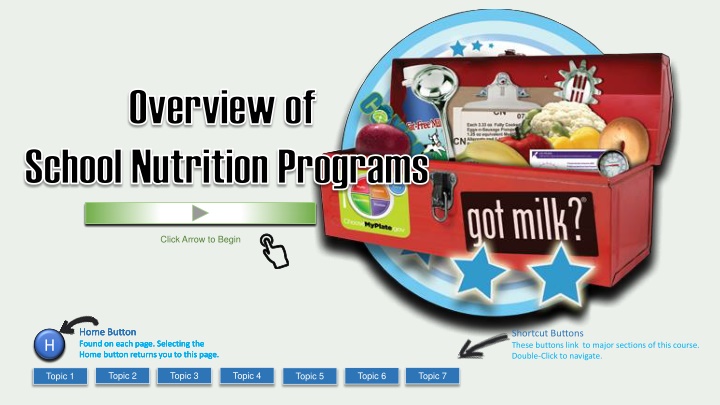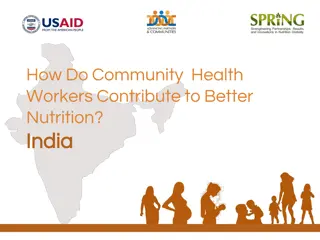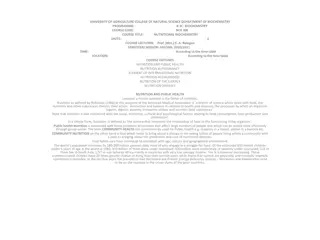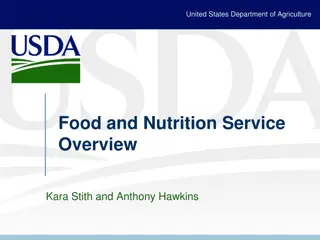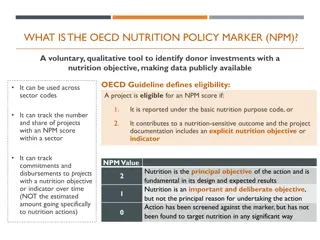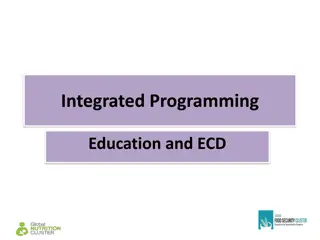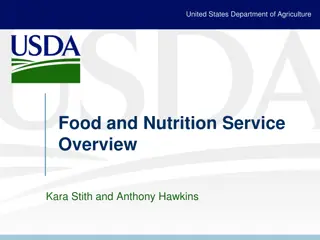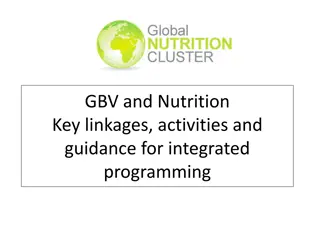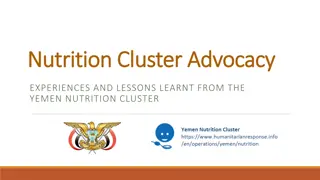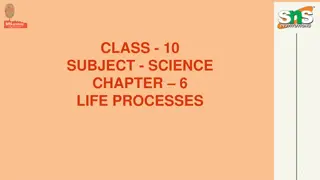Evolution of School Nutrition Programs in the United States
School Nutrition Programs in the United States have a long history dating back to the late 1800s. The National School Lunch Act of 1946 marked a significant milestone in addressing nutritional deficiencies among children. Over the years, additional programs such as the School Breakfast Program and the Special Food Service Program have been established to further support child nutrition. The evolution of these programs reflects a commitment to safeguarding the health and well-being of the nation's children.
Download Presentation

Please find below an Image/Link to download the presentation.
The content on the website is provided AS IS for your information and personal use only. It may not be sold, licensed, or shared on other websites without obtaining consent from the author.If you encounter any issues during the download, it is possible that the publisher has removed the file from their server.
You are allowed to download the files provided on this website for personal or commercial use, subject to the condition that they are used lawfully. All files are the property of their respective owners.
The content on the website is provided AS IS for your information and personal use only. It may not be sold, licensed, or shared on other websites without obtaining consent from the author.
E N D
Presentation Transcript
Overview of School Nutrition Programs Begin Course Begin Course Begin Course Begin Course Click Arrow to Begin Home Button Found on each page. Selecting the Home button returns you to this page. Home button returns you to this page. Home button returns you to this page. Home button returns you to this page. Home Button Found on each page. Selecting the Found on each page. Selecting the Found on each page. Selecting the Home Button Home Button Shortcut Buttons These buttons link to major sections of this course. Double-Click to navigate. H H H H Topic 2 Topic 3 Topic 4 Topic 7 Topic 6 Topic 1 Topic 5 Topic 2 Topic 3 Topic 4 Topic 7 Topic 6 Topic 1 Topic 5
Overview of School Nutrition Programs N NAVIGATION AVIGATION School Nutrition Toolbox School Nutrition Toolbox School Nutrition Toolbox School Nutrition Toolbox Marketing School Meals Put Course Name Here Put Course Name Here Navigation is pretty basic. Back Button, Forward Button, and Home Button. Forward Button Back Button Found on each page. Selecting the Back button returns you to the previous page. Found on each page. Selecting the Forward button advances you to the next page. Home Button Found on each page. Selecting the H H H H H H H H Home button returns you to the very beginning page. H H H H
T TOPIC OPIC 1 | H 1 | HISTORY ISTORYOF OF C CHILD HILD N NUTRITION UTRITION P PROGRAMS ROGRAMS Participants will: 1. Overview of School Nutrition Programs The rationale for the initiation of the Child Nutrition Programs. President Harry S. Truman signed the National School Lunch Act on June 4, 1946. However, school feeding is said to have begun as early as the late 1800 s. These early school feeding efforts, which were limited to a small number of schools, were largely spearheaded by volunteer parent groups and interested civic organizations. In the early 1900 s, as the problems of hunger and malnourishment became more widely recognized, the need to address these issues through school feeding programs began to capture national attention. The National School Lunch Act of 1946 authorized the establishment of the School Nutrition Program, originally known as the National School Lunch Program or NSLP. This legislation was enacted in response to reports that large numbers of American men were being rejected for military service because of nutritional deficiencies. The reason for the establishment of the School Nutrition Program as stated in the Act is: School Nutrition Toolbox School Nutrition Toolbox School Nutrition Toolbox School Nutrition Toolbox Marketing School Meals Put Course Name Here Put Course Name Here as a measure of national security, to safeguard the health and well- being of the nation s children and to encourage the domestic consumption of nutritious agricultural commodities. Continued on next slide. H H H H H H H H H H H H
T TOPIC OPIC 1 | H 1 | HISTORY ISTORYOF OF C CHILD HILD N NUTRITION UTRITION P PROGRAMS ROGRAMS Over the years, additional school feeding programs have been instituted. Overview of School Nutrition Programs Child Nutrition Act of 1966 established the School Breakfast Program as a pilot program. It was permanently authorized in 1975. The Child Nutrition Act of 1966 also authorized the Special Milk Program. In 1968, the Special Food Service Program for Children was established as a three-year pilot with two components: child care and summer feeding. In 1975 the two components were separated and authorized as the Child Care Food Program and Summer Food Service Program (SFSP). In 1978 the Child Care Food Program became a permanent program. In 1989 the name was officially changed to the Child and Adult Care Food Program (CACFP) to reflect the adult component. In 1989, certain schools were authorized to claim reimbursement for snacks served in afterschool care programs. In 1998 the After School Snack Program was expanded to allow snacks to be served through the NSLP in after school settings. The Fresh Fruit and Vegetable Program began as a pilot in 4 states and 1 Indian Tribal Organization in 2002. It expanded to 4 more states (including Pennsylvania) through the Child Nutrition and WIC Reauthorization Act of 2004. The program is now nationwide and available to a limited number of qualifying schools. School Nutrition Toolbox School Nutrition Toolbox School Nutrition Toolbox School Nutrition Toolbox Marketing School Meals Put Course Name Here Put Course Name Here H H H H H H H H H H H H
T TOPICS OPICS 2 2 AND AND 3 | H 3 | HISTORY ISTORYOF OF C CHILD HILD N NUTRITION UTRITION P PROGRAMS ROGRAMS Participants will: 1. Overview of School Nutrition Programs Name the agencies responsible for oversight of the Child Nutrition Programs at the federal and state levels. Describe the purpose and requirements for the Child Nutrition Program. 2. School Nutrition Toolbox School Nutrition Toolbox School Nutrition Toolbox School Nutrition Toolbox Marketing School Meals Put Course Name Here Put Course Name Here Topic 2 | Program Oversight The Child Nutrition Programs are administered at the federal level by the United States Department of Agriculture, Food and Nutrition Service. The state agency that administers the program and provides oversight varies from state to state but is most often the state department of education. The state agencies administer the programs through agreements with School Food Authorities. In Pennsylvania, these programs are administered by the Pennsylvania Department of Education, Division of Food and Nutrition. Participants will: 1. Describe the purpose and requirements for the Child Nutrition Program. Topic 3 | Child Nutrition Programs Description, Purpose, and Requirements The overall goal of the Child Nutrition Programs is to provide children with access to nutritious food. Continued on next slide. H H H H H H H H H H H H
T TOPICS OPICS 3 | D 3 | DESCRIPTION ESCRIPTION, P , PURPOSE URPOSE, , AND AND R REQUIREMENTS EQUIREMENTS School Nutrition Program (continued) Overview of School Nutrition Programs The SNP provides nutritionally-balanced, low-cost or free lunches to school children each school day. Public or nonprofit private schools of high school grade or under and public or nonprofit private residential child care institutions may participate. School Nutrition Toolbox School Nutrition Toolbox School Nutrition Toolbox School Nutrition Toolbox Marketing School Meals Lunches served must meet federal nutrition requirements, but the decisions about the specific foods to serve are made at the local level by the School Food Authority. Put Course Name Here Put Course Name Here Lunches must be planned so that over a week they provide no more than 30% of an individual s calories from fat and less than 10% from saturated fat. They also must provide one-third of the Recommended Dietary Allowances for protein, Vitamin A, Vitamin C, iron, calcium, and calories. If a school participates in the SNP, any child enrolled at that school must be permitted to purchase a meal through the SNP. Schools are also required to provide meals for free or at a reduced price for students who are determined to be eligible based on family income. (For more information, please check the Eligibility Determination module.) Schools that participate in the SNP receive federal and state reimbursement for every reimbursable meal served. Federal reimbursement rates are updated yearly and can be found here. State reimbursement rates are posted on CN PEARS. More information about the SNP is available at this USDA website. Continued on next slide. H H H H H H H H H H H H
T TOPIC OPIC 3 | D 3 | DESCRIPTION ESCRIPTION, P , PURPOSE URPOSE, , AND AND R REQUIREMENTS EQUIREMENTS School Nutrition Program (continued) Overview of School Nutrition Programs Local education agencies that participate in the SNP are subject to administrative reviews which occur on a 3-year cycle. This review covers the following areas: Meal Access and Reimbursement Meal Pattern and Nutritional Quality Resource Management General Program Compliance School Nutrition Toolbox School Nutrition Toolbox School Nutrition Toolbox School Nutrition Toolbox Marketing School Meals Put Course Name Here Put Course Name Here School Breakfast Program (SBP) The SBP operates in a similar manner as the NSLP. Public or nonprofit private schools of high school grade or under and public or nonprofit private residential child care institutions may participate. Breakfasts served must meet federal nutrition requirements, but the decisions about the specific foods to serve are made at the local level by the School Food Authority. Breakfasts must be planned so that over a week they provide no more than 30% of an individual s calories from fat and less than 10% from saturated fat. They also must provide one-fourth of the Recommended Dietary Allowances for protein, Vitamin A, Vitamin C, iron, calcium, and calories. For Pennsylvania schools interested in starting or expanding SBPs, free assistance is available through a program called the Breakfast Brigade, managed by Project PA. Breakfast Brigade members are school foodservice directors with expertise in school breakfast who are available to provide one-on-one consultation to schools to help with the initiation or expansion of SBPs. For more information, check the Project PA website. More information about School Breakfast is available through this USDA website. More information about the SNP is available at this USDA website. H H H H H H H H H H H H
T TOPIC OPIC 3 | D 3 | DESCRIPTION ESCRIPTION, P , PURPOSE URPOSE, , AND AND R REQUIREMENTS EQUIREMENTS Afterschool Snack Program (ASP) Overview of School Nutrition Programs The NSLP offers reimbursement to help schools serve snacks to children after the school day ends. In order to participate, the school must participate in the SNP and sponsor or operate an afterschool care program that provides children with regularly-scheduled educational or enrichment activities in a supervised environment. Snacks must contain one serving each, in the required quantity, of at least two different components of the following four: fluid milk, meat/meat alternate, vegetable or fruit (or full strength vegetable or fruit juice); whole grain or enriched bread or cereal. More information about the ASP is available through this USDA website. School Nutrition Toolbox School Nutrition Toolbox School Nutrition Toolbox School Nutrition Toolbox Marketing School Meals Put Course Name Here Put Course Name Here Special Milk Program (SMP) The SMP provides milk to children in schools and childcare institutions that do not participate in other Federal meal service programs. Schools participating in the SNP or SBP may also participate in the SMP to provide milk to children in half-day kindergarten and kindergarten programs in which children do not have access to the SBP or SNP. Participating schools receive federal reimbursement for each half pint of milk served and they must agree to use the reimbursement to reduce the selling price of milk to all children. Depending on the school s choice of program options, children may buy milk or receive it for free. Schools may choose pasteurized types of unflavored or flavored whole milk, low-fat milk, skim milk, and cultured buttermilk that meet State and local standards. All milk must contain vitamins A and D at levels specified by the Food and Drug Administration. The latest Federal reimbursement rates for the SMP can be found here. More information about the SMP is available through this USDA website. H H H H H H H H H H H H
T TOPIC OPIC 3 | D 3 | DESCRIPTION ESCRIPTION, P , PURPOSE URPOSE, , AND AND R REQUIREMENTS EQUIREMENTS Fresh Fruit and Vegetable Program (FFVP) Overview of School Nutrition Programs Unlike the other Child Nutrition Programs, the FFVP is not an entitlement program. State agencies are provided with a specific level of funding for the program. Through an application process, the state agency selects schools that meet criteria, including poverty indicators. Through the FFVP, free fresh fruits and vegetables are provided throughout the school day in elementary schools. Through a required educational component, schools teach students about the importance of good nutrition and promote consumption of fresh fruit and vegetable. More information about the FFVP is available through this USDA website. For more information about the FFVP in Pennsylvania, go to PEARS, Form Download, Fresh Fruit and Vegetable Program. School Nutrition Toolbox School Nutrition Toolbox School Nutrition Toolbox School Nutrition Toolbox Marketing School Meals Put Course Name Here Put Course Name Here H H H H H H H H H H H H
T TOPIC OPIC 3 | D 3 | DESCRIPTION ESCRIPTION, P , PURPOSE URPOSE, , AND AND R REQUIREMENTS EQUIREMENTS Summer Food Service Program (SFSP) Overview of School Nutrition Programs A child s need for good nutrition does not end when school lets out for the summer. The SFSP provides free, nutritious meals and snacks to help children in low-income areas get the nutrition they need.Through the FFVP, free fresh fruits and vegetables are provided throughout the school day in elementary schools. States approve SFSP meal sites as open, enrolled, or camp sites. Open sites operate in low-income areas where at least half of the children come from families with incomes at or below 185 percent of the federal poverty level. All meals are served for free at open sites. At enrolled sites, free meals are provided to children enrolled in an activity program at the site where at least half of them are eligible for free and reduced price meals. Camp sites may also participate in the SFSP. At camps payments are received only for meals served to children who are eligible for free and reduced price meals. More information about the SFSP is available through this USDA website. School Nutrition Toolbox School Nutrition Toolbox School Nutrition Toolbox School Nutrition Toolbox Marketing School Meals Put Course Name Here Put Course Name Here H H H H H H H H H H H H
T TOPICS OPICS 4 4 AND AND 5 | R 5 | REIMBURSEMENTS EIMBURSEMENTSAND AND P PROGRAM ROGRAM I INTEGRITY NTEGRITY Participants will: 1. 2. Overview of School Nutrition Programs Understand the funding structure for the various Child Nutrition Program. List the components of Child Nutrition Program integrity. School Nutrition Toolbox School Nutrition Toolbox School Nutrition Toolbox School Nutrition Toolbox Topic 4 | Reimbursements Marketing School Meals Put Course Name Here Put Course Name Here Schools participating in the SNP and/or SBP are required to distribute free/reduced meal applications at the beginning of each school year. Based on the information provided through these applications, students may qualify for free or reduced price meals. Schools receive federal and state reimbursement for every reimbursable meal served whether it is provided for free, at a reduced price, or at full price. However, the amount of federal reimbursement varies based on eligibility. State reimbursement provides $0.10 for each breakfast and lunch served regardless of eligibility category. Additional state funding is available based on participation in the SBP and/or the School Nutrition Incentive program. Sponsors can obtain information about the Pennsylvania state level reimbursement structure on the CN PEARS (Child Nutrition Program Electronic Application and Reimbursement System) website by logging in and clicking on Rates. Schools may qualify for higher levels of reimbursement for breakfast if they are serving a high number of low-income students. Severe need reimbursement rates are provided to schools if 40% of the lunches are served free or at a reduced price in the second preceding year. If an afterschool care program site is determined to be area eligible snacks served through the ASP are reimbursed at the free rate, regardless of an individual student s eligibility for free or reduced price lunches. An afterschool snack care program site is area eligible if it is located at a school or in the attendance area of a school where at least 50 percent of the enrolled children are eligible for free or reduced price meals. Snacks served through the ASP in afterschool care sites that are not area eligible are reimbursed based on the eligibility category (i.e., free, reduced, paid) of the participating child. H H H H H H H H H H H H
T TOPICS OPICS 4 4 AND AND 5 | R 5 | REIMBURSEMENTS EIMBURSEMENTSAND AND P PROGRAM ROGRAM I INTEGRITY NTEGRITY Topic 5 | Program Integrity Program Integrity Overview of School Nutrition Programs In order to maintain the integrity of the Child Nutrition Programs, several key practices must be in place. These practices include the following: School Nutrition Toolbox School Nutrition Toolbox School Nutrition Toolbox School Nutrition Toolbox Schools sponsoring Child Nutrition Programs must comply with all federal and state requirements for that program or programs. Meals or snacks served must contain appropriate components and meet menu planning requirements. Student eligibility for free or reduced price meals must be properly determined. Meals must be properly counted and claimed in correct eligibility categories. Marketing School Meals Put Course Name Here Put Course Name Here H H H H H H H H H H H H
T TOPICS OPICS 6 6 AND AND 7 | R 7 | REIMBURSEMENTS EIMBURSEMENTSAND AND P PROGRAM ROGRAM I INTEGRITY NTEGRITY Participants will: 1. 2. Overview of School Nutrition Programs Name the end-product of school-related legislation at both the federal and state levels. List the steps to take to get started in sponsoring a Child Nutrition Program. School Nutrition Toolbox School Nutrition Toolbox School Nutrition Toolbox School Nutrition Toolbox Topic 6 | The Law-Making Process Marketing School Meals Put Course Name Here Put Course Name Here Making and enacting laws is the responsibility of the Congress. The legislative process begins with a proposal in the form of a bill or resolution. Bills are the most common form of legislation. The bill may be introduced in either the U. S. Senate or the U. S. House of Representatives. The bill is assigned to the appropriate committee. The committee may revise the bill based on discussions and expert input. The bill is then sent to the House or Senate, depending on where it was introduced, for debate and vote. If the bill passes, it is sent to the other chamber. Changes may be made by the other chamber. When both chambers pass identical legislation the final document is presented to the President. If the bills are not identical, a special conference comprised of both chambers will reach an agreement upon a common version of the bill. If the President signs the bill it becomes law. The appropriate federal regulatory agency then creates regulations necessary to implement the law. In the case of Child Nutrition Programs, the federal regulatory agency is the USDA. Laws of the Child Nutrition Programs are codified into regulations referenced as 7CFR. Each program has a separate part in the regulations. For example, the School Nutrition Program is 7CFR, 210. At the state level in Pennsylvania, the Public School Code is a compilation of state regulations. H H H H H H H H H H H H
T TOPICS OPICS 6 6 AND AND 7 | R 7 | REIMBURSEMENTS EIMBURSEMENTSAND AND P PROGRAM ROGRAM I INTEGRITY NTEGRITY Topic 7 | Sponsoring a Child Nutrition Program: How to Get Started Overview of School Nutrition Programs Schools that participate in the Child Nutrition Programs are commonly referred to as Sponsors.The bill may be introduced in either the U. S. Senate or the U. S. House of Representatives. The bill is assigned to the appropriate committee. The Pennsylvania Department of Education, Division of Food and Nutrition, has implemented a web-based application and payment system for the federal Child Nutrition Programs. The system is called CN PEARS (PEARS for short) which stands for Child Nutrition Program Electronic Application and Reimbursement System. The first step to becoming a sponsor of the School Nutrition Program is to review and complete all new sponsor information documents which are located here. Follow the link to the New Sponsor Application Package. Once a school is approved to sponsor the School Nutrition Program, access will be given to PEARS. Sponsors of the Child Nutrition Programs submit annual program applications, monthly claims for reimbursement, building data reports, verification reports, child nutrition program financial reports, and other mandated data reports to the Division of Food and Nutrition via PEARS School Nutrition Toolbox School Nutrition Toolbox School Nutrition Toolbox School Nutrition Toolbox Marketing School Meals Put Course Name Here Put Course Name Here H H H H H H H H H H H H
Overview of School Nutrition Programs School Nutrition Toolbox H H
